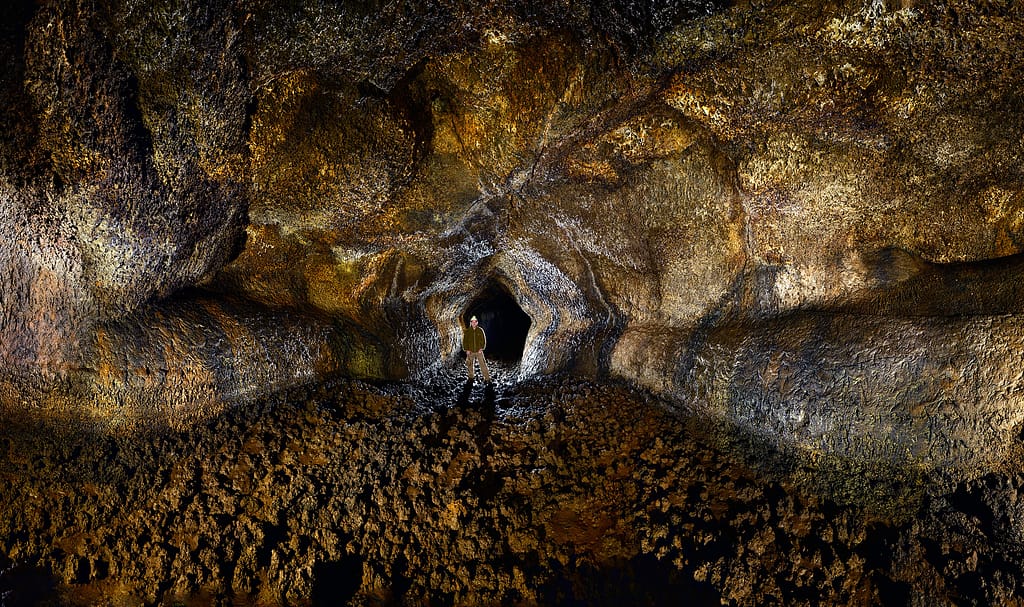Estimated reading time: 7 minutes
Cueva del Viento in Tenerife North: Exploring the Largest Lava Tube System in Europe
Take a journey to Cueva del Viento, a 17 km-long natural wonder situated on the beautiful island of Tenerife. Explore 250m of mysterious passages and discover fossils, stalagmites and more!
Cueva del Viento is a natural wonder located on the beautiful island of Tenerife, part of the Canary Islands. The cave system is known for its complex morphology, with several levels and passages that make it a unique destination for adventure seekers and nature lovers alike.
As the largest lava tube system in Europe and the sixth largest in the world, it is a must-see attraction for anyone visiting the area.
Attractions Tenerife
The cave is situated in the shadow of Mount Teide and stretches for approximately 17 kilometres, with 250 meters open for the public to explore. Visitors can witness the fascinating geological formations created by volcanic activity, including stalactites and stalagmites.
The cave is also home to a diverse range of flora and fauna, making it a perfect spot for nature enthusiasts. Icod de los Vinos, a charming town known for its wines, is nearby and serves as a great base for exploring the cave and other nearby attractions.
Location and History of Cueva del Viento, Tenerife North
As I explored the northern part of the island of Tenerife, I came across the fascinating Cueva del Viento.
Cueva del Viento
This natural wonder is located in the town of Icod de los Vinos, which is known for its rich history and stunning landscapes.
The cave system stretches for over 17 kilometres and has three different levels of passageways. Each level is full of unique geomorphological phenomena, such as lava pits and terraces.
These terraces are particularly interesting as they are evidence of the island’s volcanic history and the power of nature.
The history of the cave system is also linked to the Guanches, the original inhabitants of the Canary Islands. The Guanches were known for their unique culture and way of life, and they left their mark on the island’s landscape.
The name “Icod” is believed to be of Guanche origin, meaning “the place of the dragon tree.“
Terraces
The terraces in Cueva del Viento are a fascinating example of volcanic formations. They are created by the cooling and solidification of lava flows, which form a series of horizontal layers.
Over time, erosion and weathering have shaped the terraces into unique formations, creating a stunning display of nature’s power.
Guanches
The Guanches played an important role in the history of Tenerife, and their legacy can still be seen today. They were skilled farmers and builders, and they left behind several impressive structures, including pyramids and rock carvings.
The Guanches also had a strong connection to nature, and they believed that the island was home to powerful spirits and gods.
Geology and Formation of Cueva del Viento, Tenerife

As I explore the Cueva del Viento, I am struck by the geological wonder that surrounds me.
The cave is a remarkable example of a lava tube, a natural phenomenon that occurs when lava flows from a volcanic eruption and cools at the surface while the molten lava beneath continues to flow. As the lava drains away, a hollow tube is formed, leaving behind a cave.
Lava Tube
The Cueva del Viento is the largest lava tube system in Europe and the sixth largest in the world. It was formed 27,000 years ago by the eruption of Pico Viejo, a volcano that is part of the Mount Teide complex on the island of Tenerife.
The tube is over 17 kilometres long and has several levels and passages, making it the most complex volcanic tube in the world.
Volcanic Cavity
The Cueva del Viento is a volcanic cavity located in the district of Icod de los Vinos on the island of Tenerife.
It was formed by a series of eruptions from the Pico Viejo volcano, which is one of the most active volcanoes in the Canary Islands. The cavity is over 17 kilometres long and has a maximum depth of 70 meters.
Underground Passages
The Cueva del Viento has several underground passages that are accessible to visitors. These passages are home to a diverse range of plant and animal species, many of which are unique to the cave.
The passages are also home to several geological formations, including stalactites, stalagmites, and lava flows.
As I explore the Cueva del Viento, I am struck by the beauty and complexity of this natural wonder. The lava tube, volcanic cavity, and underground passages are a testament to the power and beauty of nature, and a reminder of the importance of preserving our natural heritage.
Visiting Cueva del Viento in Tenerife North

If you’re planning to visit Cueva del Viento, there are a few things you should know beforehand. Here’s a breakdown of everything you need to know to make the most of your visit.
Hours
Cueva del Viento is open every day of the week except for Mondays. During the summer months, the cave is open from 9:00 AM to 7:00 PM on weekdays, and from 9:00 AM to 4:30 PM on Tuesdays and Sundays.
During the winter months, the cave is open from 9:00 AM to 4:30 PM on weekdays, and from 9:00 AM to 2:30 PM on Sundays.
Tickets
Tickets for Cueva del Viento must be purchased in advance online. You can choose from several different ticket options, including a standard ticket, a ticket with a guide, and a ticket that includes a visit to the Pico Viejo Volcano. Prices vary depending on the ticket type and the time of year.
Parking
There is a parking lot located near the visitors’ centre at Cueva del Viento. Parking is free, but spaces can fill up quickly during peak hours.
If the parking lot is full, there may be additional parking available along the road leading up to the cave.
Guide
All visits to Cueva del Viento are guided, and the guides are highly knowledgeable about the cave’s history and geology. The guides speak both Spanish and English, and they are happy to answer any questions you may have during your visit.
Visitors Centre
The visitors’ centre at Cueva del Viento has a gift shop where you can purchase souvenirs and snacks. There are also restrooms and drinking fountains available for visitors to use.
Prices
Ticket prices for Cueva del Viento vary depending on the time of year and the type of ticket you purchase. Standard tickets start at around $20, while tickets that include a visit to the Pico Viejo Volcano can cost upwards of $50.
Be sure to check the website for the most up-to-date pricing information before you purchase your tickets.
That’s everything you need to know to plan your visit to Cueva del Viento. I hope you found this information helpful, and I wish you a wonderful and memorable experience exploring this unique and fascinating cave.
Plan Your Vacation with these useful links
- Find a flight
Kiwi.com – Helping you to find the cheapest airline tickets.
- Find an accommodation
Welcome to Tenerife. Enter your check-in date and choose from 9628 properties with Booking.com!
- Order taxi transfers from airports and hotels
Kiwi Taxi. Immediate departure, the driver meets you, pay online or in cash.
- Book Your Activities
Top sights you can’t miss in Tenerife! GetYourGuide.
- Rent a Car: Search, Compare, Save
Join now the many satisfied customers of Rentalcars.com – the leading car rental comparison website around the world. Only 3 steps separate you from “four wheels”!
- Ekta – is a new-generation insurance company that combines competitive prices with a high level of service.
You will receive your insurance policy by email within 2-3 minutes. There is a multilingual technical support chat 24/7.

